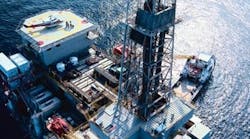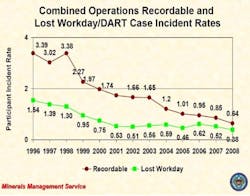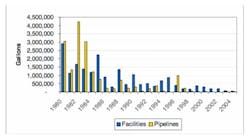Copyright © Sutton Technical Books 2011. All rights reserved.
The material in this article is extracted from Ian Sutton’s latest book, Offshore Safety Management due to be published by Elsevier in the fall of 2011, and on Process Risk and Reliability Management (2010). Mr. Sutton will also be conducting a series of seminars on SEMS.
Deepwater Horizon changed everything.
Prior to that event, which occurred in April 2010, safety trends in the offshore oil and gas industry in the United States had been improving steadily for many years, as shown in Figure 1.
Figure 1. Safety Trends — United States Outer Continental Shelf
The above chart was published by the United States Mineral Management Service (MMS) — the government agency that was responsible for the regulation of offshore safety prior to April 2010. The chart provides data to do with the number of offshore safety incidents for the period 1996-2008. The trend is impressive: In just a twelve year period the recordable injury rate declined from 3.39 to 0.64, a drop of around 80%. The number of lost workdays dropped by a similar percentage. Moreover, the trend is quite smooth and steady, showing that the results are not a fluke or one-time event. And these advances were made as the industry has worked in ever-more challenging conditions — particularly as it has moved into very deep-water operations.
Figure 2 shows a similar positive trend with respect to the industry’s environmental record. The data, which are provided by the United States Coast Guard, include some land-based facilities, and also spills from inshore (state) waters. If the two bars for each of the years in Figure 2 are combined, it can be seen that the amount of oil spilled annually has declined from just under 6 million gallons in the early 1980s to an almost negligible amount by the year 2005.
So up until the year 2010, the offshore oil and gas industry was able to demonstrate a good and steadily improving safety and environmental performance. And then, on April 20, the large and modern drilling platform Deepwater Horizon exploded, burned for about 36 hours and eventually sank. Eleven men died, the nation suffered its worst oil spill and a billion dollars-worth of equipment wound up on the bed of the sea.
In the year that has followed that event an enormous number of changes have been made in the management of safety offshore. Most of the attention has focused on specific drilling issues, particularly the integrity of blowout preventers (BOPs), but there have been sweeping management changes also. One of these changes was to reorganize and rename the MMS; it is now the Bureau of Ocean Energy Management, Regulation and Enforcement (BOEMRE). There was a wholesale change of management at the agency also.
Prior to Deepwater Horizon, the MMS had been working on the safety and environmental management systems (SEMS) rule. One of the consequences of that event was that the agency (now BOEMRE) speeded up the implementation process for SEMS. The rule was finalized in October 2010 (BOEMRE 2010). Companies operating on the outer continental shelf of the United States have to be in full compliance with this rule by November 15, 2011. The rule’s requirements are demanding. Getting into compliance will be a challenge, even for those companies that already have an effective offshore safety management system.
From SEMP to SEMS
For many years the offshore oil and gas industry in the United States had a safety and environmental program (SEMP) standard. The standard was based on the API’s Recommended Practice 75 that was itself published in response to the Piper Alpha disaster of 1988. SEMP is very similar to an onshore process safety management (PSM) program, as can be seen from inspection of Table 1.
Table 1—Elements of SEMP and PSM
The key to SEMP is that it is a voluntary program. RP 75 is a recommended practice. In the year 2004, the MMS had started toward creating their SEMS rule based on just four of the elements in Table 1. Progress was unhurried, and resistance from industry was strong. And then came Deepwater Horizon.
The public response to that event was not favorable to the MMS, which had already suffered considerable criticism based on the highly inappropriate activities of some of its employees (these activities had nothing to do with safety). Therefore, having changed its name, the agency gave high priority to SEMS.
At the heart of the SEMS rule lies the following BOEMRE statement.
BOEMRE is incorporating by reference, and making mandatory, the American Petroleum Institute’s Recommended Practice for Development of a Safety and Environmental Management Program for Offshore Operations and Facilities (API RP 75), Third Edition, May 2004, reaffirmed May 2008. This recommended practice, including its appendices, constitutes a complete safety and environmental management system (SEMS) program.
Simply put, all of RP 75 is now the law of the land. The above quotation also provides a basis for the statement that some companies have made along the lines of, “We are not concerned about SEMS because we already have an effective SEMP.” Such statements are misleading. SEMS is considerably greater in scope than SEMP.
Timing
As those with experience of process safety work will recognize, the implementation of a SEMS program is onerous—there is a lot of work to do. In the case of OSHA’s PSM standard in the early 1990s, the agency effectively provided industry with a five-year period in which to implement the program. No such grace period has been provided with SEMS. The program has to be completely in place by November 15, 2011.
Although that date is a deadline, offshore operators are not obliged to submit a written plan on the lines of the EPA’s risk management program (RMP). But they can be audited at any time, and they will have to defend their SEMS progress in the event of an accident.
Level of Compliance
Before the SEMS rule was issued, the MMS did some research to find out how many companies had a good SEMP program in place. The results of their work are shown in Table 2.
Table 2—Types of Operators
The agency divided oil and gas operators into three broad categories depending on their level of activity: High, Moderate and Low. The division depends on the thousands of barrels of oil equivalent (MMBOE) per day produced.
The first conclusion to be drawn from Table 1 is that large companies should have little trouble meeting the SEMS rule, since all thirteen of the large operators show that they are 100% in compliance with SEMP. This does not mean, however, that these companies do not have some make-up work to do. As already discussed, BOEMRE has added a considerable amount of material to SEMP. It is possible that some of the high-activity companies may still find that there are areas in which they do not meet the requirements of SEMS.
Table 2 shows that there are 41 moderate-activity operators. They report good compliance with SEMP. But, as discussed for the larger operators, they may still have a considerable amount of work to do to comply with the SEMS rule.
The largest number of operators is in the low-activity category. Table 2 shows that most of these operators do not have an effective SEMP. Given the very short amount of time available to implement a SEMS program, these companies will be challenged to meet the deadline.
A final comment to be made about Table 2 is that the information in it is based on self-reporting, not on an independent audit. Therefore, it is possible that some companies may have indulged in a little unjustified optimism or wishful thinking. It has also been reported (Bromwich, 2011) that the percentage of companies meeting the SEMP requirements has been slipping.
Plan B
Those companies that do not have a full SEMP in place will have to implement a catch-up plan. The development and organization of such a plan is outside the scope of this article, but the following high-level guidance is offered.
The plan should be risk-based. This means that a company will identify those areas or operations that are of the highest risk and address them first. Doing so not only helps minimize the possibility of a catastrophic event, but also provides a good defense should the facility be audited.
Based on the risk plan, it is suggested that the SEMS work be organized as follows:
- Update the P&IDs and other critical technical documents.
- Ensure that the management of change program is working effectively.
- Conduct a major hazards analysis (MHA).
- Start the HAZOPs, prioritized according to the findings of the MHA.
- Implement the findings of the HAZOPs and other studies.
- Repeat for the lower risk items.
Rather than conduct a risk ranking, another approach would be to work on the following four elements first:
- Mechanical Integrity
- Operating Procedures
- Hazards Analysis
- Management of Change
These elements were selected by MMS in the early versions of SEMS as being the most critical, based on their own research. Therefore to give them priority would make sense. Details as to how to implement these elements are provided by Sutton (2010). Also, the Offshore Operators Committee is developing useful industry guidance.
It is likely that BOEMRE will have trouble conducting a large number of audits in the near future because it faces the same ramp-up problems as does industry, particularly the need to find and hire properly qualified process safety professionals. Still, it will probably conduct some early audits—if only to set a precedent.
Concusions
Of the many changes that have come out of the Deepwater Horizon catastrophe one of the most important is that companies operating on the outer continental shelf have to implement a SEMS, and they have to do it quickly; November 15, 2011, will soon arrive. It is likely that the regulators will themselves have trouble getting up to speed. Nevertheless, they may conduct audits at any time, and those audits could result is serious penalties.
For those companies that clearly are not going to meet the deadline, it is suggested that a risk-based approach be used to create a plan and then that the plan be followed.
Citations
BOEMRE. 30 CFR Part 250. "Oil and Gas and Sulfur Operations in the Outer Continental Shelf—Safety and Environmental Management Systems." 2010.
Bromwich, M. "Future of Offshore Oil and Gas Development in the U.S." Offshore Technology Conference. May 2011.
Sutton, Ian S. Process Risk and Reliability Management. Elsevier, Oxford, England. 2010.
For more information visit http://www.stb07.com/bookshop/bookshop-index.html and http://www.stb07.com/index.html
If you’re interested in SEMS, register for our complimentary webinar on at http://www.stb07.com/seminars/o-sys-sems.html.
Latest from Safety Instrumented Systems

Leaders relevant to this article:







